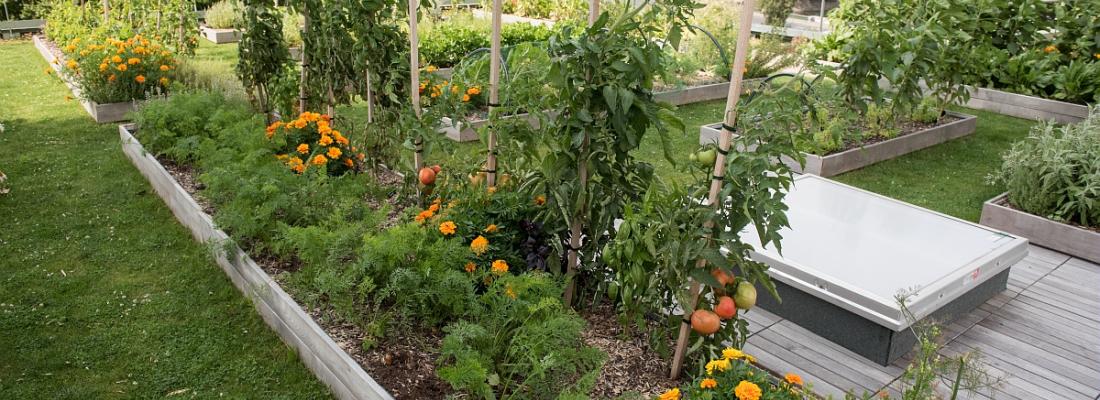Agroecology Reading time 5 min
Installing rooftop vegetable gardens for sustainable cities
Published on 20 December 2017

The challenges of making today’s cities more sustainable are legion: waste management, food supplies, sensitivity to heatwaves and the risk of flooding linked notably to the impermeabilisation of soils. These issues are an invitation to re-think how cities are designed, and urban farming is one solution, among others, likely to foster ecological functioning and generate ecosystem services. But land constraints and the risk of urban soil pollution prevent such initiatives from being carried out. That’s where productive rooftops come in; they are a key solution to developing urban farming and leaving more room for nature in cities.
In order to evaluate the ecosystem services inherent to this form of agriculture, innovative and experimental gardens that put urban waste to good use were installed on rooftops. The experiment revealed, notably, that productive rooftops give good output, with levels of heavy metals within established norms.
Rooftop gardening: good yields and efficient retention of rainwater
The scientists showed that production levels in rooftop gardens are comparable, or even better, than those of traditional family vegetable gardens (between 4.4 and 6.1kg/m² per growing season), and close to those of professional organic vegetable growers in the Paris region. Yields were essentially the same between the models tested, with Technosols composed of urban waste proving to be as productive as commercial potting soil, if not more so.
The three types of Technosols retained more than three quarters of incident rainfall, unlike bare roofs. Regardless of the type of Technosol, heavy metal content (Cd, Cu, Pb, Zn and Hg) of vegetables was considerably lower than established standards.
Lastly, the organic waste used on the rooftop gardens decomposes, gradually releasing its components. By taking stock of all inputs (rainwater and additional watering) and outputs (drainage), the researchers found that Technosols retain more nitrate than they give off. However, they give off more dissolved carbon in runoff water than the commercial potting soil.
Toward green cities that provide many ecosystem services
These findings show that low-tech productive rooftops, which are easy to manage, allow organic waste to be recycled and vegetables to be produced by harnessing rainwater and without recourse to chemical fertilisers. Making productive rooftops a part of urban landscapes is a real opportunity for designing cities that provide many ecosystem services. However, more studies must first be carried out on the best types of soils for this type of urban farming.
“Today, everyone is talking about short distribution channels. Urban farming is an opportunity to make this thinking a reality in the heart of cities, and to bring about real improvement in terms of society and the environment”, says Christine Aubry, co-author of the study.
|
Green rooftops: a practical guide In the heart of Paris, on the roofs of the Paris Institute of Technology for Life, Food and Environmental Sciences (AgroParisTech), scientists have planted a vegetable garden. For two years, following the rhythm of the seasons, they grew lettuce (Lactuca sativa), cherry tomatoes (Lycopersicum esculentum var. cherry) and green fertilisers (Trifolium incarnatum and Secale cereale) spaced 50cm apart in wooden trays (90 cm x 90 cm x 40 cm). They compared three Technosols, i.e. man-made soil. The first two consisted of 50% compost from organic waste and 50% wood chips from the upkeep of urban spaces. Earthworms were added to one Technosol but not the other. The third Technosol was a commercial potting soil, used as a control over the course of the experiment. No mineral fertilisers were used: the biodegradation of organic waste was the only source of nutrients for the plants. The researchers looked at four ecosystem services: the production of food (quantity and quality of yields); the recycling of waste; the regulation of water runoff (quantity of rain water collected and quality of water drainage); and the potential for storing carbon. |
This study was financed within the framework of the field of major interest “Agro-science, ecology of territories, food” (DIM Astrea) of the Île-de-France region, and by “Ecodesign of buildings and infrastructure” (Vinci, ParisTech). The experimental rooftop installations were made possible thanks to funding from the scientific board of AgroParisTech.
|
References Baptiste J.-P. Grard, Claire Chenu, Nastaran Manouchehri, Sabine Houot, Nathalie Frascaria-Lacoste, Christine Aubry. Rooftop farming on urban waste provide many ecosystem services. Agronomy for Sustainable Development (2018) 38: 2. https://doi.org/10.1007/s13593-017-0474-2. |
